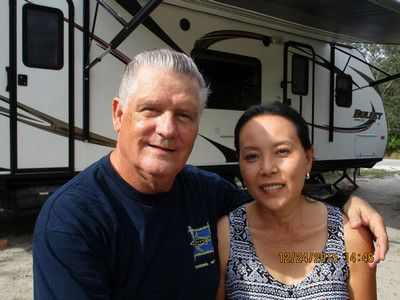South Bay RV Campground
Camping can be a real delightful
experience if you’re in the right park at the right time of the year.
We’ve only been RV camping since
2006, but we now have our favorite campgrounds on a list of those we frequent
the most here in Southwest Florida, I mean like every few weeks or so without
fail.
Summertime in our neck of the
woods is a lot of humidity with almost predictable rain showers in the
afternoon.
So, with that in mind, we always
do our fishing in the morning and are usually finished before noon.
Since my birthday is in mid
summer, I get to choose the one campground we love among our favorites. For us, South Bay RV Campground is that
special place.
Our drive is a few hours East
from our home on the Gulf side of the state, of course we make our usual stop
at the Wal-Mart in Clewiston for some last minute goodies for our weeklong
stay.South Bay RV Campground is actually located about 18 miles East of Clewiston in a small town called South Bay……….go figure!
The entire park is surrounded by
a small canal that is filled with fish of all kinds, a couple small alligators,
and there’s even a small lake called Shiner Lake, where I’ve even caught and
eaten some big Channel Catfish……..YUMMY!
Shiner Lake has a walking path
all around it so anyone can get his or her exercise walking or riding a bike.
South Bay RV Campground is under
the supervision of Palm Beach County, so all the 100 plus 30 Amp and 50 Amp
campsites are all paved with water, sewer and even cable TV, as well as
Wi-Fi. For the kids, there’s even a
playground. If you like to have a group
meeting onsite, you can use the Pavilion recreation hall, you can also use one
of the two laundry rooms if you need it, where your clothes will be super
safe. There are also 18 handicap spaces
available should you require one.
Someone is in the office
everyday except Sunday’s and when you check in, they give you a little packet
showing where your site is, and the gate code to get in after hours.
One of the major advantages of
camping at South Bay is the fact that it is right next to the largest lake in
the state of Florida, Lake Okeechobee!
Which just happens to be famous for its bass fishing.
You just drive out the front
gate, go up the dyke, and down the other site to the rim canal and boat launch. You can’t see the main lake from here, but
there is plenty of fishing in more calm waters.
The next closest town is Belle
Glade and is only a few miles North of South Bay. They have massive sugar cane fields and a large processing plant
nearby.
Since I like to also choose a
good restaurant for my special day, we love to eat at a place in Belle Glade
called Wah Lan’s. You guessed it; some
great Chinese food served buffet style.
Don’t know how its possible, but the waitress actually remembers us
every year, so she’s very accommodating.
Although Lake Okeechobee is
noted for great bass fishing, and it is, there is also some great fishing for
channel catfish, which I love eating, some crappie, which I’ve never personally
caught, plentiful bluegills, which I catch and release a lot of, except for
what I use to catch bass with, Mayan Cichlids, which I also love eating, and a
few other types of fish I normally don’t keep.
Yes, there are a few alligators around, but they not only don’t let you get very close, but they just overall leave you alone and watch from a distance, thank goodness.
Yes, there are a few alligators around, but they not only don’t let you get very close, but they just overall leave you alone and watch from a distance, thank goodness.
During the summer months,
usually from June through September, you can camp for half price, which makes
this a super great deal for anyone who is willing to put up with that summer
humidity.
Overall, we highly recommend
camping at South Bay RV campground anytime you get the chance. Happy Camping!
Please visit us for some great videos and stories!
Please visit us for some great videos and stories!









